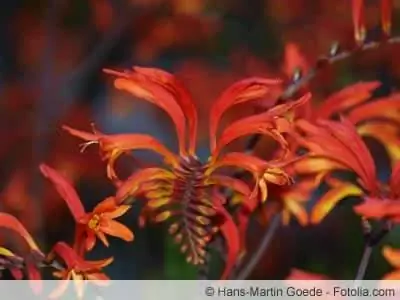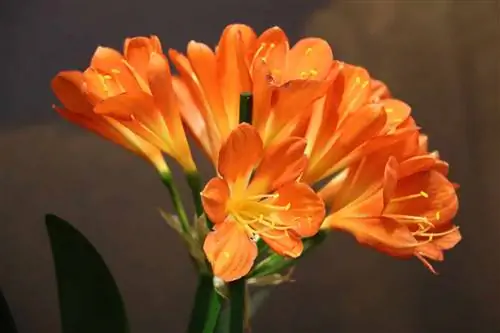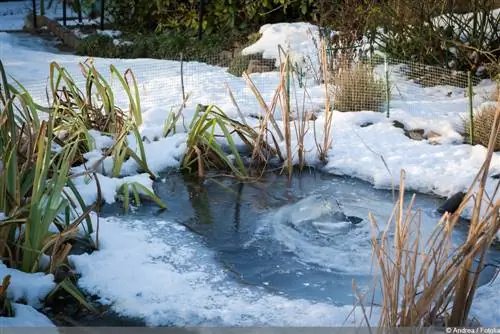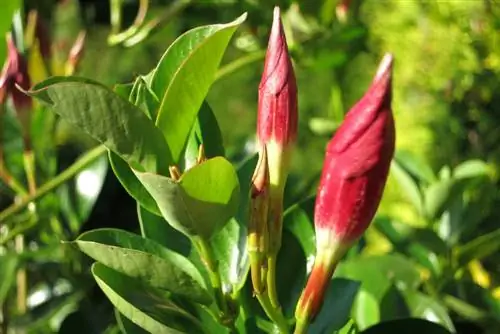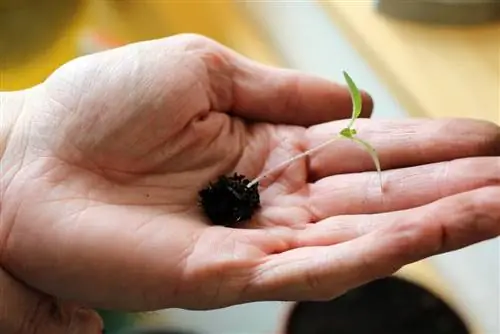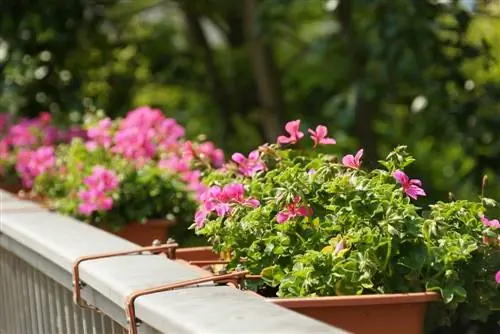- Author admin [email protected].
- Public 2023-12-17 03:39.
- Last modified 2025-06-01 06:48.
In terms of growth, the Crocosmia is reminiscent of irises, gladioli and freesias. The Montbretias originally come from South Africa and love moist soil in partially shaded to sunny locations. It forms tubers (rhizomes). They can overwinter without any problems in protected locations, especially in milder areas of Germany. The lush panicles with their fiery flowers hang on long, straight stems. This also makes them attractive as cut flowers. As evergreen, herbaceous perennials, Crocosmia botanically belong to the order Asparagales and the iris family (Iridaceae).
Location
The Montbretien species like it warm and protected. A sunny to partially shaded location is therefore ideal. The flowers and foliage will not develop optimally in full sun or in fully shaded areas. A south-facing wall or house wall gives them warmth and protection from cold winds for longer. A slight slope is also well suited. The water can drain well here because the roots and tubers of the Crocosmia are quite susceptible to root rot. Montbretias can also be cultivated in pots. On terraces and balconies, their fire blossoms create exotic accents in front of house walls or green hedges.
Floor
As long as the pH value doesn't go to extremes, the Montbretias get along well with almost any soil. Just make sure the soil is sufficiently loose. As already mentioned, roots and tubers are prone to rot. If the soil is too solid, heavy and contains clay, adding sand can help. Slightly sloping beds are ideal locations. It is best to create a drainage layer in a large container before adding the potting soil with the tubers.
Plants
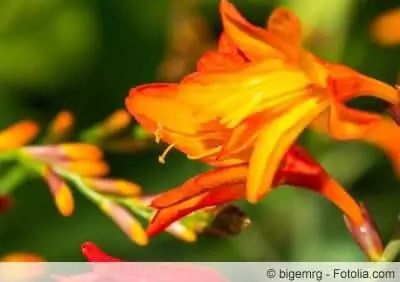
There are many colorful varieties to choose from in the nurseries. They are offered as tubers. You can start planting the tubers as early as March. The selected location is previously loosened well and, if necessary, mixed with sand. The tubers now come with the shoot tip upwards (clear), approximately 3 times the size of the tuber deep, into the soil (approx. 8-20 cm). The harsher the climate, the deeper they should be planted to protect against frost. They are particularly effective when placed in groups or in a row along a path. A planting distance of 10 - 20 cm from each other is ideal. A good starting condition is to mix the excavated earth with compost soil. After filling, just pour heavily. For subsequent frosts into May, it is advisable to initially cover the area with leaves, compost or pine branches. It can take some time until the first shoot tips can be seen, sometimes until the end of April if the ground temperatures are cool. Depending on the variety, they reach a height of 60 - 100 cm. The Crocosmia have particularly good neighbors:
- Grasses
- Coneflower
- Sedum
- Girl's Eye
- Sweet Thistle
- Beardflower
- Summer grid
- Spurweed
- generally heat-loving plants that do not form extensive, strong roots
Watering and fertilizing
For lush flowering in summer, the Crocosmia should definitely be fertilized additionally. A long-term fertilizer in spring is sufficient for this. It is best to feed potted plants with a liquid fertilizer once a week. Today's varieties also tolerate calcareous goat water. However, there is no question that they prefer rainwater. Watering should be done when the soil is dry a few centimeters deep at the latest; they should never dry out completely. Water the potted plants at the latest when the substrate on the surface has dried out.
Tip:
As other care, the Montbretians appreciate careful loosening of the soil every now and then. The potted plants should be repotted every 3 years.
Wintering
The Montbretien species are conditionally hardy. Depending on the weather conditions prevailing at the location, protective measures should be taken for the winter. In late autumn, the above-ground parts of the plant die off and the tuber overwinters in the ground. A blanket of leaves, brushwood or mulch is usually enough to protect them from frost. In very cold areas it is better to dig up the tubers in autumn. They can then overwinter in a cool, dark, but frost-free room until spring. The crocosmia in the pot definitely need a cool and dark place in winter. As soon as the leaves change color and die, they are removed and the pots are moved to winter storage. Here they don't need water until the temperatures are above freezing again in early spring. Now they get water and their first fertilizer.
Propagate
The easiest way to propagate the Montbretias is through their new secondary tubers. The best time is when the dormant phase is still free of frost. The young tubers are numerous among the older ones. After four years it is advisable to rejuvenate the plant, a good time to carefully separate the secondary tubers in order to use them again in the spring or to give them away. Propagation by seeds is possible, but also more complicated and not always successful:
- Collect seeds before the first frost
- store dry and dark
- prefer in the house from February
- Soak the seeds in water beforehand
- Place in nutrient-poor substrate
- the seeds germinate in light, cover only a little with soil
- keep evenly moist
- Time until germination: several weeks
- Time until the first flowering: several years
Varieties

There are now many different, very flowering and robust varieties of Crocosmia on the market. The most popular are:
- Crocosmia 'Emily McKenzie': orange-gold with red eye; Flowering from July to September
- Crocosmia 'George Davidson': large yellow flowers from July to September, well suited as a cut flower
- Crocosmia 'Emberglow': orange with yellow eyes, long flowering: July to October
- Crocosmia masoniorum 'Lucifer': large, bright red flowers; good winter hardy
- Crocosmia masoniorum 'Norwich Canary': buttery yellow, large flowers; Flowering from July to August
Diseases and pests
Diseases and pests are fortunately not a big issue for the Crocosmia species. If the plants are worried or show leaf irregularities, it is usually due to care or waterlogging. Only voles occasionally pose a threat to the tubers. The tubers can be placed in a wire mesh for protection. Another option is to cover the entire bed with a wire net 25-30 cm deep before planting. Fungi are responsible for the root and tuber rot already mentioned. The affected plants cannot be saved even with fungicides. Permeable soil and good drainage are essential for the survival of he althy Montbretias.
Conclusion
Especially for regions with a more temperate climate (maritime climate, lowlands), the Montbretias are an easy-care and eye-catching, exotic addition to the garden. As soon as the first buds have opened in summer, they can be cut off for the vase and radiate their exotic charm into the house on rainy, sunny days. But even overwintering is not too labor-intensive and is rewarded with long-lasting blooming fireworks in the summer.

